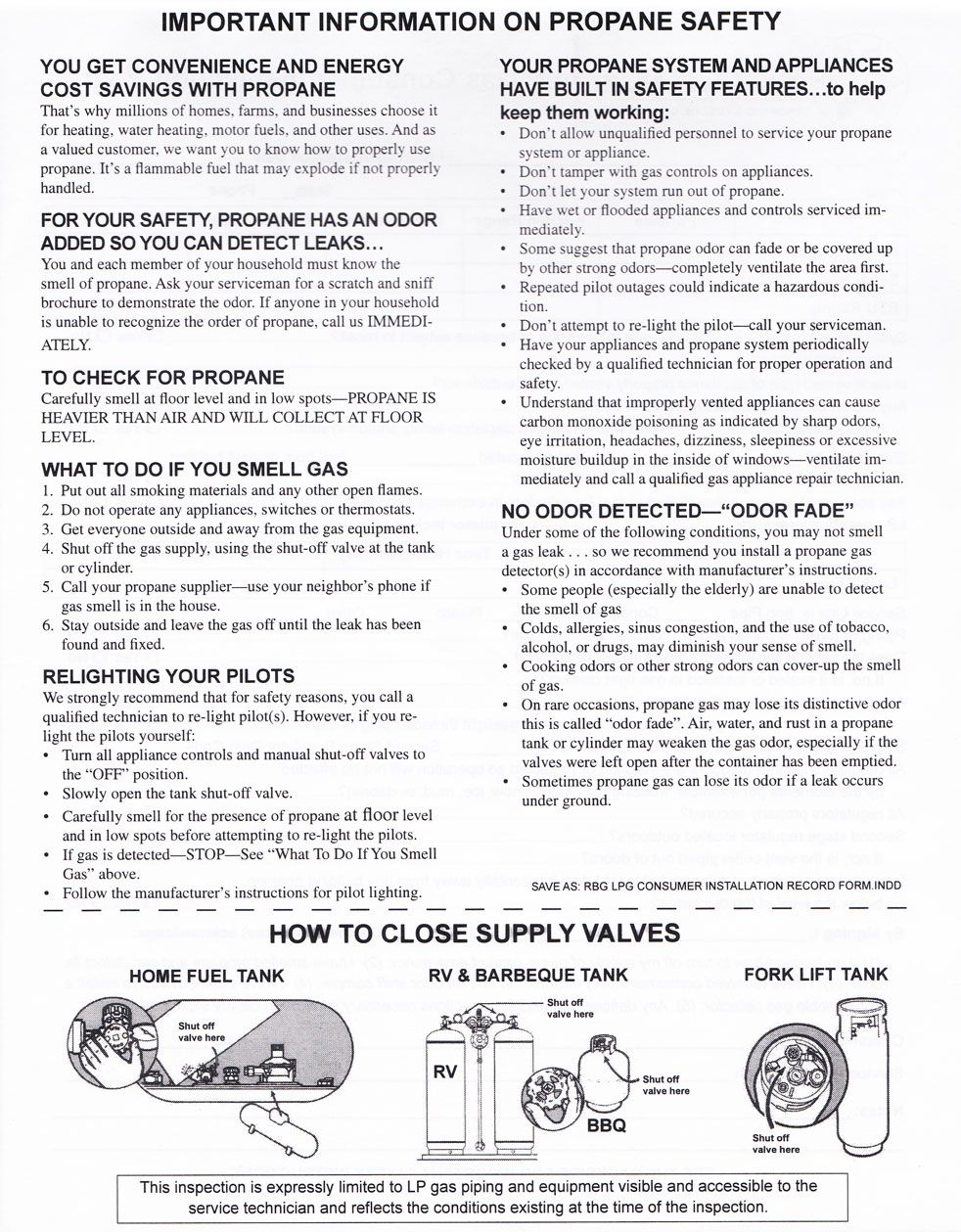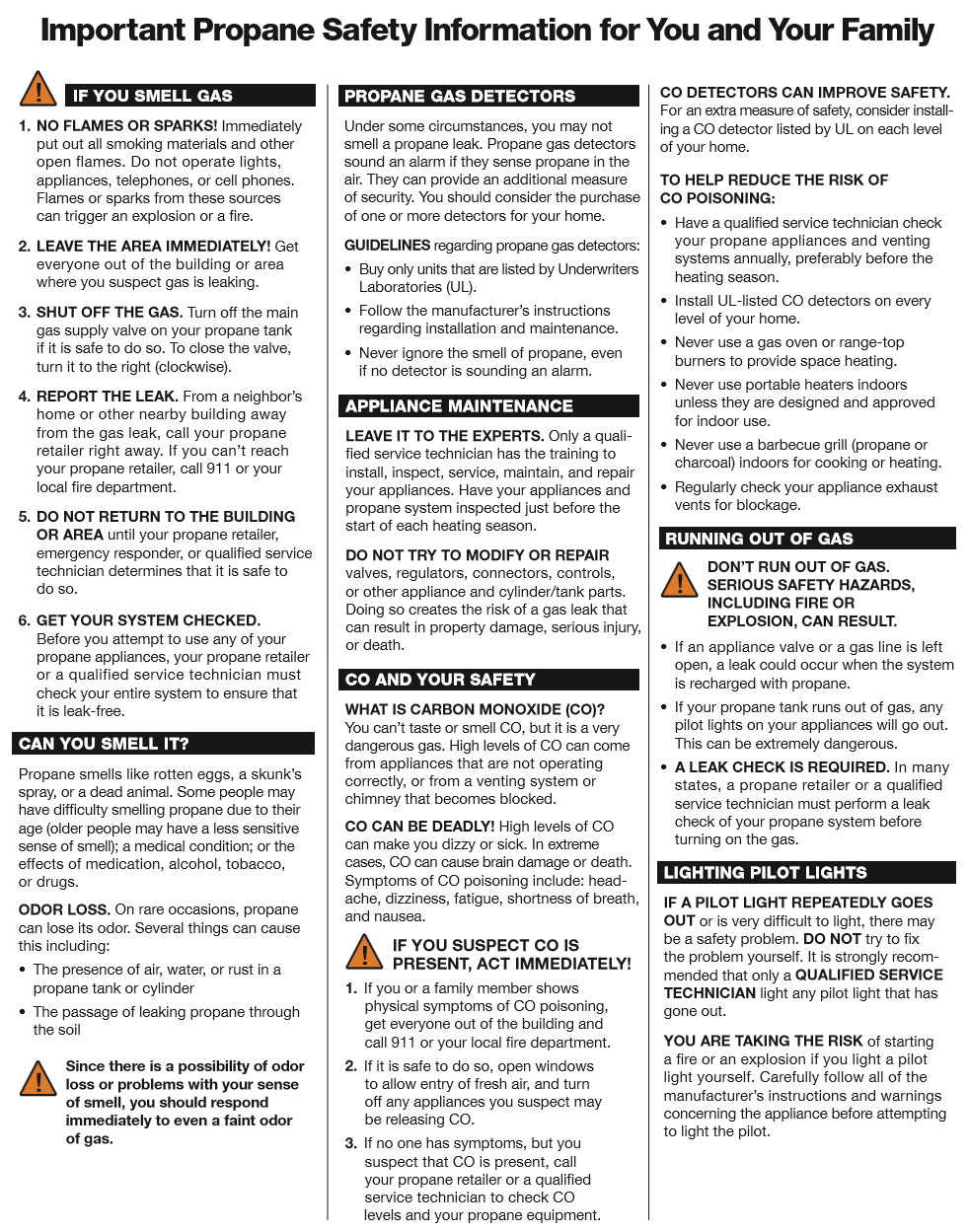PROPANE SAFETY INFORMATION
Know Your Propane System
Your propane system has four basic parts:
1. A tank or cylinder equipped with a main shutoff valve.
2. One or more regulators designed to reduce pressure between the container and your appliance(s).
3. Gas piping, to carry the propane to your appliance(s); and
4. Gas appliance(s).
The tank or cylinder is where the propane is stored. It is equipped with a shutoff valve, which turns the gas “on” or “off”. The regulator controls the gas pressure, while the gas piping carries the gas to your appliance(s).
It is important for you to know the location of the main shutoff valve on the tank or cylinder. Remember its location and become familiar with how to shut ir off in an emergency situation.
Out of Gas!
Letting your propane container run empty creates additional hazards. If you do run out of gas, follow these steps:
1. Turn off all control valves on all gas appliances.
2. Turn off the shutoff valve on the propane container(s).
3. Call Reliance at 419.473.1374 to arrange for delivery, and advise them you are out of gas.
4. Don’t turn the gas back on! Let Reliance do it. When you schedule your fill, be sure it is for a time when you will be home so Reliance can relight and safety-check your system to assure that it is operating properly and is leak free.
Energy-Saving Tips for Your Home
Home Heating
- Residential heating systems need regular tune-ups. Contact Reliance Energy at 419.473.1374 to inquire about a home-heating system inspection program.
- Change your furnace filter monthly. Clean filters will save you money on your heating bill.
- Consider investing in a furnace thermostat timer that can save money by lowering your home’s temperature when you are not home.
- Protect against drafts around windows and doors by caulking and weather-stripping.
- If you are purchasing a fireplace, consider selecting on fueld by propane. Propane fireplaces burn more efficiently than wood burning models and distribute heat more evenly throughout the room.
Water Heaters
- You can save more that 10 percent on your water-heating bill by turning down your water heater from the standard 140 degrees to 130 degrees.
- To extend your water heater’s life and increase energy efficiency, drain it every six months to remove lime deposits and sediment.
- Install flow-restricting shower heads. You can reduce hot water usage by up to 50 percent without affecting shower pressure.
- Repair leaky faucets. A leak that fills a coffee cup in 10 minutes wastes 3,200 gallons of water a year.
Home Appliances
- Gas ranges with electronic ignition systems will use 40 percent less energy than a standing pilot system.
- Be sure that all burners are burning with a blue, cone-shaped flame. A yellow flame indicates clogged air inlets or burners that need adjustment. Contact Reliance Energy’s service department immediately at 419.473.1374 if you do not see a blue flame.
- Check the seal on your oven door. Gaps or tears in the seal will let heat escape and waste energy.
Safeguard Your Propane Home from Winter Storms
Follow this safety checklist for what to do before, during, and after storms.
Did you know that a gas leak can occur if accumulated snow and ice damage your propane system? Taking simple steps before, during, and after snowstorms can reduce this risk.
Follow these tips to have a safe and comfortable winter season no matter what the weather brings:
Have an adequate supply of propane in your tank. In high snowfall areas, roads leading to your home might not be accessible for delivery, particularly after a snowstorm. It is recommended that you establish a regular delivery schedule with your propane retailer.
Keep snow and ice from accumulating on propane equipment. Gently brush away snow or ice that has accumulated around the tank, meter, regulator, and any other piping. Do this using a broom or by hand. If you notice any snow or ice buildup that cannot be removed easily, contact your propane retailer immediately. DO NOT attempt to remove snow or ice by kicking or hitting equipment.
Be alert to snow buildup on rooftops and other areas. Frequently check where snow or ice collect on your roof, structure, or nearby trees and clear it if you believe it might fall on any part of your propane system. Never shovel snow off roofs and onto propane equipment.
Keep vents clear. Appliance vents and chimney flues must ALWAYS be clear of snow or ice. Some homes may have “direct” vents, which are close to the ground. Improper venting can cause carbon monoxide to become trapped in your home, causing serious illness or even death.
Clear driveways and pathways to propane tanks. A propane delivery truck needs at least a 10-foot-wide path to drive up to your house to deliver fuel. Also, keep the tank area and a path to the tank free of snow. When plowing, snow blowing, or shoveling, do not push or pile snow around your tank, meter, regulator, or piping.
Mark your tank and regulator. It is important to mark your tank and equipment to enable emergency and propane service personnel to locate them at all times. Check local ordinances about marking tanks and regulators, and follow any rules applicable to your jurisdiction.
More safety tips for high snowfall areas. PDF



